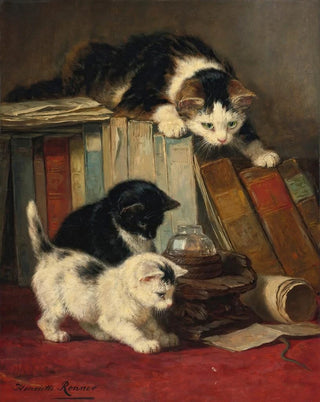Art print | Watching the prey - Henriette Ronner-Knip


View from behind

Frame (optional)
Henriette Ronner-Knip – Captivating Introduction
In the world of art, some works manage to capture the very essence of animal life with such intensity that they transcend the simple frame of painting. "Looking at the prey - Henriette Ronner-Knip" is one of these creations, where harmony between the subject and the artist manifests with striking clarity. This piece not only evokes the beauty of felines but also the depth of a gaze that seems to tell a story, a moment suspended between instinct and contemplation. Through this representation, Ronner-Knip invites us to delve into the fascinating universe of animals, while revealing the complexity of human emotions reflected within.
Style and uniqueness of the work
Ronner-Knip's technique is distinguished by meticulous attention to detail and her ability to capture light in a way that gives an almost lifelike dimension to her subjects. In "Looking at the prey," every hair of the cat is rendered with precision that demonstrates a deep respect for nature. The color palette, subtle and nuanced, plays a vital role in creating an intimate atmosphere, where the viewer is invited to share a moment of introspection with the animal. The composition, both balanced and dynamic, creates a dialogue between the cat and its environment, reinforcing the idea that every exchanged gaze between living beings can be loaded with meaning. This work is a true homage to wild beauty, while also reflecting on the human condition.
The artist and her influence
Henriette Ronner-Knip, an emblematic figure of the 19th century, managed to establish herself in an artistic environment dominated by men. Her passion for animals, particularly cats, was expressed through a series of creations that marked her era. Influenced by the artistic movements of her time, she skillfully combined tradition and innovation, integrating elements of realism into her work. Her talent allowed her to make a name for herself in the art world, and her unique style inspired many contemporary artists. By focusing on animal life, she also paved the way for a new approach to nature in art, where the emotions and behaviors of animals are

Matte finish

View from behind

Frame (optional)
Henriette Ronner-Knip – Captivating Introduction
In the world of art, some works manage to capture the very essence of animal life with such intensity that they transcend the simple frame of painting. "Looking at the prey - Henriette Ronner-Knip" is one of these creations, where harmony between the subject and the artist manifests with striking clarity. This piece not only evokes the beauty of felines but also the depth of a gaze that seems to tell a story, a moment suspended between instinct and contemplation. Through this representation, Ronner-Knip invites us to delve into the fascinating universe of animals, while revealing the complexity of human emotions reflected within.
Style and uniqueness of the work
Ronner-Knip's technique is distinguished by meticulous attention to detail and her ability to capture light in a way that gives an almost lifelike dimension to her subjects. In "Looking at the prey," every hair of the cat is rendered with precision that demonstrates a deep respect for nature. The color palette, subtle and nuanced, plays a vital role in creating an intimate atmosphere, where the viewer is invited to share a moment of introspection with the animal. The composition, both balanced and dynamic, creates a dialogue between the cat and its environment, reinforcing the idea that every exchanged gaze between living beings can be loaded with meaning. This work is a true homage to wild beauty, while also reflecting on the human condition.
The artist and her influence
Henriette Ronner-Knip, an emblematic figure of the 19th century, managed to establish herself in an artistic environment dominated by men. Her passion for animals, particularly cats, was expressed through a series of creations that marked her era. Influenced by the artistic movements of her time, she skillfully combined tradition and innovation, integrating elements of realism into her work. Her talent allowed her to make a name for herself in the art world, and her unique style inspired many contemporary artists. By focusing on animal life, she also paved the way for a new approach to nature in art, where the emotions and behaviors of animals are






